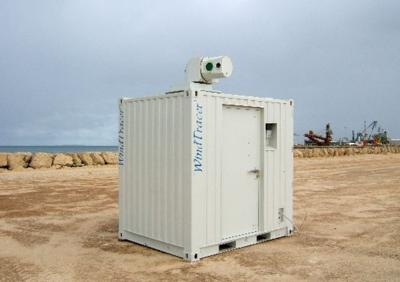Mon, Feb 18, 2013
Lidar Measurements Led To Reduction In Diagonal Spacing On Adjacent Runways
The FAA has applied hundreds of thousands of research measurements made by Lockheed Martin's WindTracer Doppler lidar to redefine flight rules, achieving major efficiency enhancements at U.S. airports.

The FAA granted approval for San Francisco International Airport (SFO) and Newark Liberty International Airport (EWR) to conduct dependent arrival operations on their closely spaced parallel runway (CSPR) pairs. SFO and EWR have joined a growing list of airports with CSPR geometries that are authorized by the Federal Aviation Administration to conduct a wake turbulence mitigation procedure for CSPR operation, known as FAA Order JO 7110.308 – Ch3. The safety assessment is enabled with significant amount of wake measurement research using WindTracer lidars.
The assessment permits reduced diagonal spacing of 1.5 nautical miles on adjacent runways relative to the leading large- and small-category aircraft with runway spacing less than 2500 feet under Instrument Flight Rules. Before the implementation of 7110.308, planes arriving on two such CSPRs were required to be spaced as if they were using a single runway, which effectively closed down one of the parallel runways under instrument conditions. This procedure at SFO and EWR is expected to reduce delays significantly.
"We are thrilled that the FAA has employed our WindTracer Doppler lidars to achieve these critical improvements to U.S. air traffic rules," said Dr. Michael Margulis, director of WindTracer Programs at Lockheed Martin. "These changes will greatly increase U.S. civil airspace capacity while maintaining the highest standards of air traffic safety."
The FAA Wake Turbulence Research Program has been using WindTracer systems since 2001 at multiple airport locations to conduct wake turbulence research measurements. The databases are carefully mined to provide data-driven assessment of ongoing and future wake turbulence mitigation concepts. In addition, wind data collection is also used to develop weather-based wake mitigation solutions.
The John A. Volpe National Transportation Systems Center, part of the U.S. Department of Transportation's Research and Innovative Technology Administration, maintains and operates a fleet of WindTracers for the FAA Wake Turbulence Research Program and provides data analysis and other resource supports.
(WindTracer image courtesy Lockheed Martin)
More News
Charted Visual Flight Procedure Approach An approach conducted while operating on an instrument flight rules (IFR) flight plan which authorizes the pilot of an aircraft to proceed >[...]
“When l became the Secretary of Defense, I committed to rebuild our military to match threats to capabilities. Drones are the biggest battlefield innovation in a generation, >[...]
Aero Linx: Stearman Restorers Association Welcome to the Stearman Restorers Association. The Stearman Restorers Association is an independent “Not for Profit” 501C-3 Co>[...]
Airplane Exhibited A Partial Loss Of Engine Power When It Was About Halfway Down The Runway Analysis: The pilot of the experimental amateur-built airplane was departing from his pr>[...]
The Flight Path Was Consistent With Low-Altitude Maneuvering On June 18, 2025, about 0922 mountain standard time, a Cessna A150L airplane, N6436F, was substantially damaged when it>[...]
 ANN's Daily Aero-Term (07.15.25): Charted Visual Flight Procedure Approach
ANN's Daily Aero-Term (07.15.25): Charted Visual Flight Procedure Approach Aero-News: Quote of the Day (07.15.25)
Aero-News: Quote of the Day (07.15.25) ANN's Daily Aero-Linx (07.15.25)
ANN's Daily Aero-Linx (07.15.25) NTSB Final Report: Kjelsrud Gary Kitfox
NTSB Final Report: Kjelsrud Gary Kitfox NTSB Prelim: Cessna A150L
NTSB Prelim: Cessna A150L



